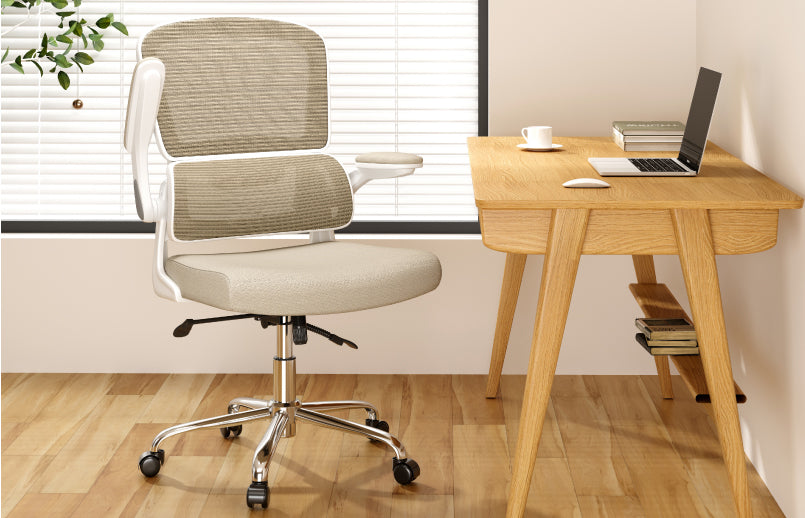Optimizing the Work Experience: the Importance of the Right Chair Height
Guarantee an ideal work experience by adjusting your chair height correctly. Proper chair height promotes posture, enhances productivity, and prevents discomfort and musculoskeletal issues. The right seat height aligns joints, reduces muscle strain, and supports your body effectively. With personalized adjustments and tailored seat heights, you can maintain comfort and boost productivity. Don’t overlook the importance of chair ergonomics for your physical well-being. Explore further for practical advice on chair adjustments and future trends in chair height for a conducive work environment.
Optimizing the work experience: the importance of the right chair height

Sitting for extended periods can have significant implications for both your health and productivity in the workplace. Research shows that the proper chair height is essential in maintaining proper posture and reducing the risk of musculoskeletal issues.
The impact of prolonged sitting in the modern work environment on health and productivity
Research indicates that prolonged periods of sedentary behavior in the modern work environment can greatly impact both the health and productivity of individuals. The sitting epidemic, with its health consequences, has been linked to a sedentary lifestyle prevalent in many work-related settings. Individuals with desk jobs often lack posture awareness, leading to musculoskeletal issues and decreased productivity due to the negative effects of prolonged sitting. Workplace ergonomics play a crucial role in addressing these challenges, with chair height being a key factor in promoting better posture and reducing the negative impacts of prolonged sitting on health and productivity.
| Impact of Prolonged Sitting on Health and Productivity |
|---|
| Health Consequences |
| - Musculoskeletal issues |
| - Increased risk of obesity and chronic diseases |
| - Reduced cardiovascular health |
The importance of correct chair height to improve the work experience
Elevating your work experience to its peak level involves recognizing the critical role of having the right chair height for maintaining proper posture and enhancing productivity in the workplace.
Comfortable seating is essential to prevent discomfort and fatigue, allowing you to focus on your tasks with ease.
An efficient workspace starts with a chair that supports your body correctly, promoting healthy posture and reducing the risk of musculoskeletal issues.
Ergonomics Overview
You’re about to explore the fundamental concept of ergonomics, which involves designing workspaces and tools to fit the people who use them.
Understanding the basic principles of ergonomics can greatly enhance comfort and productivity in the workplace.
Explain the definition and basic principles of ergonomics
Understanding ergonomics involves designing and arranging workspaces to fit the needs and capabilities of the individuals using them. Ergonomics aims to enhance workplace comfort, provide health benefits, improve efficiency, prevent injuries, and optimize ergonomic design. By integrating ergonomic principles into workspace layouts, equipment design, and tasks, companies can create environments that promote well-being and productivity.
| Ergonomic Principles | Description |
|---|---|
| 1. Anthropometry | Considers human body measurements for best workspace design. |
| 2. Biomechanics | Focuses on how the body moves during work tasks to prevent strain. |
| 3. Environmental Factors | Considers lighting, noise, and temperature for overall well-being. |
| 4. Cognitive Ergonomics | Addresses mental workload and decision-making processes for efficiency. |
Discuss the application of ergonomics in office chair design
You’ll find that personalized seat height adjustments play an essential role in ensuring ideal comfort and support for every individual.
Ergonomics in office chair design focuses on creating adjustable features that cater to a wide range of body types and preferences.
Research indicates that proper seat height alignment can help reduce discomfort, improve posture, and boost productivity in the workplace.
Why personalized seat height adjustments are critical for everyone
Personalized seat height adjustments play a significant role in ensuring ideal comfort and productivity for individuals in various work environments. This customization contributes to health benefits, a productivity boost, and overall workplace wellness.
Ergonomic design principles emphasize the importance of tailored seat heights to prevent discomfort and musculoskeletal issues, ultimately enhancing the work experience and promoting a healthier, more efficient workspace for all.
Correct Seat Height for Physical Health

Adjusting your chair to the correct height is essential for maintaining a natural posture and proper joint alignment, which can greatly reduce muscular and skeletal stress.
Research shows that incorrect seat height can lead to various musculoskeletal issues, such as back pain, neck strain, and shoulder discomfort.
Ensuring your seat height is optimized for your body can positively impact your physical health and overall well-being in the workplace.
How correct seat height promotes natural posture and joint alignment and reduces muscular and skeletal stress
Achieving the correct seat height is essential for promoting natural posture, aligning joints, and reducing muscular and skeletal stress in the workplace. When your chair is at the right height, your body is positioned ideally, allowing for proper alignment of your spine, shoulders, and hips. This alignment not only enhances your posture but also decreases the strain on your muscles and bones.
By maintaining a neutral spine and keeping your feet flat on the ground, you can prevent issues such as back pain and stiffness. Correct seat height also plays an important role in aligning your joints, ensuring that they aren’t under unnecessary pressure or strain during long hours of work. This alignment helps in distributing your weight evenly, reducing the risk of joint discomfort and enhancing overall comfort.
Musculoskeletal problems that can result from incorrect seat height
Neck Pain: Incorrect seat height can lead to straining of the neck muscles as you tilt your head forward or backward to see your screen properly.
Lower Back Pain: Sitting too low or too high can cause your lower back to curve unnaturally, leading to discomfort and potential long-term issues.
Shoulder Tension: If your chair isn’t adjusted correctly, you may find yourself hunching your shoulders or raising them to reach your desk, causing strain and tension.
Hip Discomfort: Sitting with your seat too high or too low can affect your hip alignment, potentially leading to hip pain and discomfort over time.
To mitigate these health risks, make sure your seat is at the correct height to maintain proper postural alignment. Implement preventive measures through workplace ergonomics training and make accurate adjustments to your chair to support your body adequately.
The Key to Increased Productivity
Adjusting your chair height might seem like a small change, but it can meaningfully impact your productivity levels.
Research shows that the right seat height can enhance your focus and cognitive abilities.
Correct seat height improves productivity and concentration
Proper chair height greatly influences both productivity and concentration levels in the workplace. When your chair is at the correct height, several benefits come into play:
-
Improved Focus: A chair set at the right height allows you to align your body properly, reducing distractions and enabling you to concentrate better on your tasks.
-
Enhanced Comfort: Adjusting the chair height to fit your body prevents discomfort, such as back pain or neck strain, which can otherwise hinder your ability to focus and work efficiently.
-
Increased Efficiency: With the chair at the ideal height, you can move freely and access your workspace without unnecessary strain, leading to a smoother workflow and higher productivity levels.
-
Boosted Performance: By maintaining a correct seating posture, you’re likely to experience enhanced cognitive function and overall performance, translating into better outcomes and achievements in your work tasks.
Ensuring your chair height is right not only fosters productivity but also contributes to a positive work environment by promoting an elevated mood and overall well-being.
Optimized posture improves breathing and blood circulation, which supports brain function and decision-making
Maintaining an optimized posture not only enhances breathing and blood circulation but also supports brain function and decision-making, ultimately revealing the key to increased productivity.
When you sit with proper posture, your body aligns in a way that allows for ideal blood circulation throughout your entire system. Improved circulation means that oxygen and nutrients can reach your brain more efficiently, enhancing cognitive function and supporting better decision-making abilities.
Furthermore, correct posture leads to better breathing patterns. When you sit or stand upright, your lungs have more room to expand, allowing for deeper breaths. This increased oxygen intake not only benefits your overall health but also directly impacts your brain function.
Oxygen is essential for maintaining alertness, concentration, and mental clarity, all of which are vital for making well-informed decisions in the workplace.
Practical Adjustment Advice

To optimize your work experience, adjusting your chair height is essential for comfort and productivity. Proper chair height allows for proper alignment of your body, reducing strain on your back and neck.
Follow ergonomic guidelines to make sure your chair is at a height that allows your feet to rest flat on the floor and your knees to form a 90-degree angle.
How to adjust chair height?
Adjusting the height of your chair is crucial for maintaining proper posture and minimizing discomfort during long hours of work. To optimize your chair height effectively, follow these steps:
-
Start at the Right Level: Begin by adjusting your chair so that your feet are flat on the floor and your knees are at a 90-degree angle.
-
Check Armrest Position: Confirm that your armrests are at a height where your arms can rest comfortably, maintaining a relaxed shoulder position.
-
Align with Your Desk: Adjust the chair height so that your elbows are at the same level as the desk, allowing for proper alignment when typing or using a mouse.
-
Test for Comfort: Sit back in your chair after making adjustments and make sure your lower back is supported by the chair’s lumbar support.
Future trends in chair height and the work environment
As workplaces continue to evolve and prioritize ergonomic solutions, the upcoming trends in chair height are poised to revolutionize the work environment. Chair design is moving towards more customizable options, allowing for height adjustment tailored to individual needs. This shift not only enhances comfort but also promotes better posture and overall workplace wellness.
Innovations in sitting solutions are integrating cutting-edge comfort technology into chair design. Features like lumbar support, adjustable armrests, and memory foam padding are becoming standard, ensuring that individuals can work for extended periods without discomfort or strain. These advancements in chair height aren’t only about ergonomic benefits but also about improving productivity and focus in the workplace.
Furthermore, the future of chair height in the work environment is likely to see a more seamless integration of technology. Smart chairs equipped with sensors that provide feedback on sitting habits and posture may become prevalent, offering real-time suggestions for the most suitable sitting positions.
Frequently Asked Questions
Can the Right Chair Height Improve Mental Well-Being at Work?
Yes, the proper chair height can greatly impact mental well-being at work. Ergonomic benefits like posture support lead to a productivity boost. Proper alignment reduces strain, elevating mood and enhancing focus.
Physical comfort from a well-adjusted chair fosters a positive work environment. Make sure your chair height is tailored to your body to reap these benefits and optimize your mental well-being during work hours.
How Does Chair Height Impact Overall Job Satisfaction?
Elevating your work experience through ideal chair height boosts comfort, productivity, and physical well-being. Proper chair height enhances posture health, positively impacting overall job satisfaction.
When your chair aligns perfectly with your body, it fosters a sense of well-being, leading to improved comfort levels and increased productivity. This attention to detail in chair height contributes greatly to your overall job satisfaction and physical well-being.
Are There Specific Chair Height Recommendations for Different Body Types?
When it comes to chair height recommendations for various body types, ergonomic guidelines suggest customized adjustments for maximum health benefits. Tailoring chair height based on individual needs enhances comfort preferences and provides essential posture support.
Can Adjusting Chair Height Help Prevent Common Workplace Injuries?
Adjusting your chair height is essential for injury prevention, ergonomic benefits, and enhanced productivity.
By setting the chair at the proper height, you can maintain a neutral posture, reduce strain on your muscles, and prevent common workplace injuries like back pain or carpal tunnel syndrome.
This simple adjustment guarantees that your body is properly supported, leading to a more comfortable and efficient work experience.
Is There a Correlation Between Chair Height and Employee Engagement Levels?
Adjusting chair height can impact productivity levels and employee comfort, thereby affecting physical health and collaboration opportunities. The right chair height contributes to a conducive work environment, promoting engagement and efficiency.
Research indicates that proper ergonomics, including chair height, can positively influence employee engagement levels. By optimizing this aspect, organizations can create a workspace that prioritizes both physical well-being and job satisfaction.
Conclusion
You think chair height is just a minor detail in your work setup, but it’s actually a major player in your overall well-being and productivity.
Don’t underestimate the power of a properly adjusted chair - it could be the key to unleashing your full potential at work.
So next time you’re feeling a little off at your desk, take a second look at that chair height and make the necessary adjustments. Your body and mind will thank you.

























 United States
United States
Leave a comment